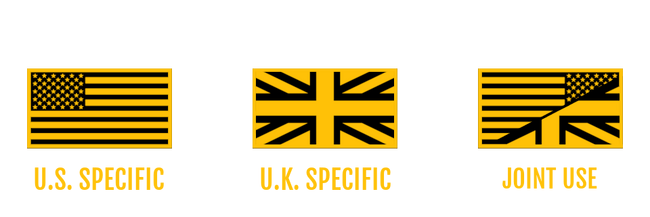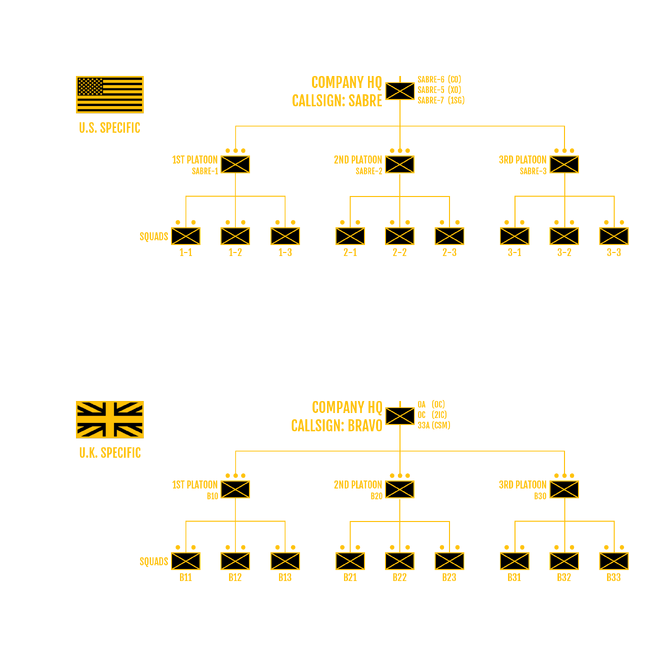Tag: Visual edit |
|||
| Line 26: | Line 26: | ||
<br /> |
<br /> |
||
=== 3. '''Voice Procedure''' === |
=== 3. '''Voice Procedure''' === |
||
| − | Voice Procedure is used in order to get the most amount of information across in the shortest possible time. Airtime is precious and as much as possible needs to be reserved for command and control, so reducing the amount of relayed unnecessary chatter is vital. To facilitate brevity and accuracy, VP employs a number of prowords with specific jargon or meanings and rules associated to them, which are largely standardised throughout NATO. Good net discipline can be maintained by following some basic rules, which are demonstrated via a table and guideline system shown below: |
+ | Voice Procedure is used in order to get the most amount of information across in the shortest possible time. Airtime is<br /> precious and as much as possible needs to be reserved for command and control, so reducing the amount of relayed<br /> unnecessary chatter is vital. To facilitate brevity and accuracy, VP employs a number of prowords with specific jargon<br /> or meanings and rules associated to them, which are largely standardised throughout NATO. Good net discipline can<br /> be maintained by following some basic rules, which are demonstrated via a table and guideline system shown below: |
{| class="article-table" |
{| class="article-table" |
||
!Golden Rules |
!Golden Rules |
||
| Line 40: | Line 40: | ||
|“SABRE-1-6, SABRE-1-6 this is SABRE, message over” |
|“SABRE-1-6, SABRE-1-6 this is SABRE, message over” |
||
| − | “Roger SABRE, this is SABRE-1-6, send traffic over”<br> |
+ | “Roger SABRE, this is SABRE-1-6, send traffic over”<br /> |
“SABRE-1-6, initiate movement at this time to checkpoint Three Two Tango, Break, how copy over?” |
“SABRE-1-6, initiate movement at this time to checkpoint Three Two Tango, Break, how copy over?” |
||
| Line 53: | Line 53: | ||
<br /> |
<br /> |
||
<br /> |
<br /> |
||
| + | |||
=== 3a. '''Prowords''' === |
=== 3a. '''Prowords''' === |
||
text<br /> |
text<br /> |
||
Revision as of 16:44, 4 July 2019
Text
Radio Communications
The purpose of this section is to introduce fundamental tactical radio communications at the Company and Platoon
level, including basic Voice Procedure on the Combat Net Radio (or CNR). Communicating effectively is a crucially
important aspect of warfare fieldcraft; especially in how it pertains for command and control, situational awareness,
and battlefield information across the battlespace. It is especially vital for Commanders, NCOs and Radio Operator
personnel who need to understand how to pass on critical information swiftly, accurately and with appropriate need.
Standard operating procedures vary between countries and even different units, although NATO countries follow a
common standard when necessary. The scope of this guide covers US and UK/Commonwealth variations. Varied
relevant parts have been labelled to clearly indicate these differences. Proper net discipline and accurate, realistic
communications not only enhance unit effectiveness but also increase the capability and capacity for any said unit.
1. Combat Net Radio & Radio Nets
Unit level radio nets at Battalion and above are formal nets. They have watchkeepers maintaining their set 24 hours
listening watch, are fully logged and require scheduled reports, returns and requests (R3) as well as regular use of
command, control or admin traffic. As such, there is a prescribed amount of formal protocol that applies specifically
toward these nets. At a sub-unit level (Company and below), command nets are usually informal although standard
Voice Procedure (VP) still applies. At a Section or Squad level, short range nets used on Personal Role Radios are
considered ‘chat nets’, although it is good practice to follow standard VP regardless of what broadcast level is used.
A Light Infantry Company operates a single command net with occasional use of additional nets for busier operations
in order to declutter the command net, such as an Admin net or Offensive Support (Fires) net for Forward Observers,
Forward Air Controllers or Joint Terminal Attack Controllers attached to the subunit. Each Platoon has their separate
Platoon Command net, sometimes referred to in the US as an Assault net. Finally, each Section / Squad has a PRR
chat net. Fire Teams work on the Section/Squad net but Team Leaders will monitor (listen to) the Platoon Command
net on a separate radio. The Battalion Signals Officer distributes frequency allocations, call signs and passwords via
Communications Electronic Instruction (CEI) ahead of operations. As a rule it is better to use as few nets as possible.
2. Call Signs
Call signs provide a means of uniquely identifying each station on a net. Call signs will vary slightly depending on the
structure and type of unit and even unit SOP, but this guide focuses on a generic Light Infantry Company. While both
the US and UK follow a slightly different approach, there is logic to both system that require the Operator understand.
In the US Army, a Company is allocated a call sign identifier, often starting with the letter of the Company (e.g. Sabre,
Dagger or Raider, etc). Platoons are designated with a number (Sabre-1 for 1 Platoon). Additionally, a unit leadership
position each has a number affixed: 7 for NCOs, 6 for Commanders, 5 for Executive Officers. Hence Sabre-7 is a unit
Company First Sergeant. Sabre-1-6 is Sabre Company, 1 Platoon Leader. Support platoons are often given a unique,
separate callsign (e.g. Steel for mortar platoon). For brevity once comms have been established, the total identifier is
omitted and only numbers are used. New call signs joining the net must announce themselves with the full call sign/ID.
On the Platoon nets, Squads use the same call sign with their squad number affixed. Hence Sabre-1-1 is 1 Platoon
1st Squad; Sabre-1-1-A is 1 Platoon, 1st Squad, Alpha Team. “Actual” is appended to any call sign to specify a team
commander, as opposed to the Radio Telephone Operator (RTO) who would otherwise routinely answer their radios.
In the UK, a call sign indicator (often a phonetic letter or unique word) is allocated to each sub unit. Platoons and the
Sections are designated by number, for example the “B10” (pronounced Bravo One Zero) is B Company, 1 Platoon,
where Bravo is the call sign indicator allocated to B Company in the CEI. “Alpha” specifies the Commander, so B10A
is 1 Platoon Commander. This can be further broken down to designate Sections and Fire Teams, hence B11 is their
1 Platoon, 1 Section; F11C is 1 Platoon, 1 Section, Charlie Fire Team. This system continues throughout platoon level.
Leadership positions have fixed call signs: 0A is the Company Commander, 0C is the 2IC, 33A is the given Company
Sergeant Major. 0 (Zero) is the Control Station and is typically manned by their Radio Operator. On the Platoon nets,
Sections use the same call signs though in this context 0A is the Platoon Commander, 0B the Platoon Sergeant, etc.
3. Voice Procedure
Voice Procedure is used in order to get the most amount of information across in the shortest possible time. Airtime is
precious and as much as possible needs to be reserved for command and control, so reducing the amount of relayed
unnecessary chatter is vital. To facilitate brevity and accuracy, VP employs a number of prowords with specific jargon
or meanings and rules associated to them, which are largely standardised throughout NATO. Good net discipline can
be maintained by following some basic rules, which are demonstrated via a table and guideline system shown below:
| Golden Rules | Consider this | Compared to this |
|---|---|---|
|
“SABRE-1-6, SABRE-1-6 this is SABRE, message over”
“Roger SABRE, this is SABRE-1-6, send traffic over” “SABRE this is SABRE-1-6, Roger Wilco, moving to checkpoint Three Two Tango, I am Oscar Mike over” “SABRE-1-6 this is SABRE Roger Out” |
“SABRE-1-6 this is SABRE, move now to Checkpoint Three Two Tango, over”
“SABRE-1-6, Roger Out” |
3a. Prowords
text
3b. Incorrect Prowords
text
4. Reports
text
5. Support Requests
text
5a. Fire Missions
text
5b. Close Air Support
text
5c. Casualty Evacuation
text
6. Call Sign Matrix Example
text
Rules of Engagement
text
Operations Order (OpOrder)
text
Order of Battle (ORBAT)
Text
Terminology Glossary
text


